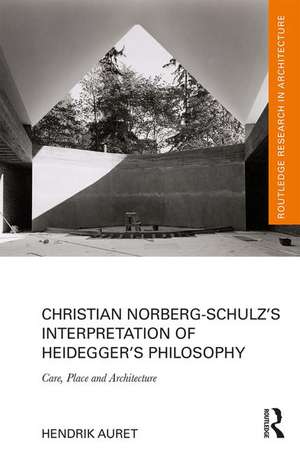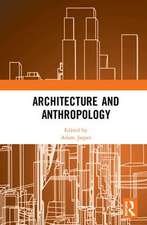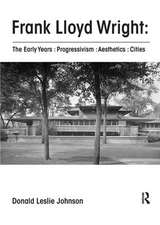Christian Norberg-Schulz’s Interpretation of Heidegger’s Philosophy: Care, Place and Architecture: Routledge Research in Architecture
Autor Hendrik Aureten Limba Engleză Hardback – 9 oct 2018
This book seeks to realign Norberg-Schulz’s understanding of time as continuity and change to present a holistic approach grounded in Heidegger’s phenomenological philosophy; architecture as art of care. Aimed at academics and scholars in architectural theory, history and philosophy, Christian Norberg-Schulz’s Interpretation of Heidegger’s Philosophy surveys the implications and significance of Norberg-Schulz's works on architectural criticism in the late 20th century.
| Toate formatele și edițiile | Preț | Express |
|---|---|---|
| Paperback (1) | 385.54 lei 6-8 săpt. | |
| Taylor & Francis – 30 sep 2020 | 385.54 lei 6-8 săpt. | |
| Hardback (1) | 767.20 lei 6-8 săpt. | |
| Taylor & Francis – 9 oct 2018 | 767.20 lei 6-8 săpt. |
Din seria Routledge Research in Architecture
- 9%
 Preț: 901.22 lei
Preț: 901.22 lei -
 Preț: 310.45 lei
Preț: 310.45 lei -
 Preț: 312.22 lei
Preț: 312.22 lei - 9%
 Preț: 1004.48 lei
Preț: 1004.48 lei -
 Preț: 312.44 lei
Preț: 312.44 lei -
 Preț: 351.26 lei
Preț: 351.26 lei -
 Preț: 309.89 lei
Preț: 309.89 lei -
 Preț: 311.48 lei
Preț: 311.48 lei -
 Preț: 311.66 lei
Preț: 311.66 lei - 9%
 Preț: 866.04 lei
Preț: 866.04 lei - 9%
 Preț: 936.16 lei
Preț: 936.16 lei -
 Preț: 449.41 lei
Preț: 449.41 lei - 31%
 Preț: 767.07 lei
Preț: 767.07 lei - 26%
 Preț: 766.24 lei
Preț: 766.24 lei - 12%
 Preț: 299.52 lei
Preț: 299.52 lei -
 Preț: 449.41 lei
Preț: 449.41 lei - 30%
 Preț: 768.30 lei
Preț: 768.30 lei -
 Preț: 449.41 lei
Preț: 449.41 lei -
 Preț: 489.26 lei
Preț: 489.26 lei - 18%
 Preț: 1003.43 lei
Preț: 1003.43 lei -
 Preț: 442.68 lei
Preț: 442.68 lei -
 Preț: 449.41 lei
Preț: 449.41 lei - 18%
 Preț: 1109.99 lei
Preț: 1109.99 lei - 26%
 Preț: 849.37 lei
Preț: 849.37 lei -
 Preț: 489.26 lei
Preț: 489.26 lei - 18%
 Preț: 998.71 lei
Preț: 998.71 lei - 18%
 Preț: 1054.71 lei
Preț: 1054.71 lei -
 Preț: 443.65 lei
Preț: 443.65 lei - 18%
 Preț: 1001.07 lei
Preț: 1001.07 lei - 26%
 Preț: 766.24 lei
Preț: 766.24 lei - 24%
 Preț: 324.16 lei
Preț: 324.16 lei - 26%
 Preț: 766.24 lei
Preț: 766.24 lei - 28%
 Preț: 708.63 lei
Preț: 708.63 lei - 26%
 Preț: 765.01 lei
Preț: 765.01 lei - 18%
 Preț: 1057.75 lei
Preț: 1057.75 lei - 26%
 Preț: 850.17 lei
Preț: 850.17 lei -
 Preț: 449.41 lei
Preț: 449.41 lei - 25%
 Preț: 716.13 lei
Preț: 716.13 lei - 26%
 Preț: 765.84 lei
Preț: 765.84 lei - 18%
 Preț: 1274.14 lei
Preț: 1274.14 lei - 18%
 Preț: 1165.20 lei
Preț: 1165.20 lei
Preț: 767.20 lei
Preț vechi: 1029.17 lei
-25% Nou
Puncte Express: 1151
Preț estimativ în valută:
146.81€ • 153.66$ • 122.19£
146.81€ • 153.66$ • 122.19£
Carte tipărită la comandă
Livrare economică 31 martie-14 aprilie
Preluare comenzi: 021 569.72.76
Specificații
ISBN-13: 9780815378266
ISBN-10: 0815378262
Pagini: 250
Ilustrații: 8 Line drawings, black and white; 20 Halftones, black and white; 6 Tables, black and white; 28 Illustrations, black and white
Dimensiuni: 156 x 234 x 19 mm
Greutate: 0.62 kg
Ediția:1
Editura: Taylor & Francis
Colecția Routledge
Seria Routledge Research in Architecture
Locul publicării:Oxford, United Kingdom
ISBN-10: 0815378262
Pagini: 250
Ilustrații: 8 Line drawings, black and white; 20 Halftones, black and white; 6 Tables, black and white; 28 Illustrations, black and white
Dimensiuni: 156 x 234 x 19 mm
Greutate: 0.62 kg
Ediția:1
Editura: Taylor & Francis
Colecția Routledge
Seria Routledge Research in Architecture
Locul publicării:Oxford, United Kingdom
Public țintă
PostgraduateCuprins
Preface 1. Introduction 2. Christian Norberg-Schulz and the art of place 3. Heidegger’s concept of care 4. The art of care 5. Conclusion Glossary of terms Endnotes Acknowledgements Bibliography Archival material
Notă biografică
Hendrik Auret is a senior lecturer at the University of the Free State (UFS), South Africa, and registered as a professional architect. In 2007 he won the National Corobrik Architectural Student of the Year Award, the title accorded the best master’s design dissertation from all South African architecture learning sites. Hendrik received his Ph.D. in architecture from the UFS in 2015. This is his first book.
Recenzii
‘Christian Norberg-Schulz was one of the preeminent 20th-century architectural theorists. Auret critically reviews how Martin Heidegger’s philosophy grounded Norberg-Schulz’s architectural phenomenology and how contemporary architecture might be revitalized as an "art of care" that envisions buildings and places as spatial-temporal "regions of care." Auret offers a convincing, supportive counter to recent critical studies that undercut Norberg-Schulz’s work, claiming it is a misreading of Heidegger. The book is a timely contribution to architectural theory, especially environmental hermeneutics and architectural phenomenology.’
David Seamon, Kansas State University, USA; Editor, Environmental and Architectural Phenomenology
"In many ways, Christian Norberg-Schulz’s place theory is more relevant today than when it was first written. That is why Hendrik Auret´s book is important and timely. The book provides a comprehensive consideration of Norberg-Schulz’s lifelong search for a deeper understanding of how architectural work is related to life. Auret´s research is attentive and thorough, and he presents his work regarding the "art of care" as a way towards designing and appreciating architecture as an art of life."
Gro Lauvland, Associate Professor, Norwegian University of Science and Technology, Norway
'In his book, Christian Norberg-Schulz’s Interpretation of Heidegger’s Philosophy, Hendrik Auret has provided significant insight into a crucial ‘blind spot’ in Norberg-Schulz’s interpretation of Heidegger’s fundamental ontological account of human being, or Dasein – one that might have made an important difference in his understanding of the implications of Heidegger’s thought for architecture. Far from resigning himself to accepting that Norberg-Schulz’s work is terminally vitiated by this omission, however, Auret has managed to breathe new life into the Norwegian’s work instead.'
Bert Olivier, Department of Philosophy, University of the Free State, South Africa
David Seamon, Kansas State University, USA; Editor, Environmental and Architectural Phenomenology
"In many ways, Christian Norberg-Schulz’s place theory is more relevant today than when it was first written. That is why Hendrik Auret´s book is important and timely. The book provides a comprehensive consideration of Norberg-Schulz’s lifelong search for a deeper understanding of how architectural work is related to life. Auret´s research is attentive and thorough, and he presents his work regarding the "art of care" as a way towards designing and appreciating architecture as an art of life."
Gro Lauvland, Associate Professor, Norwegian University of Science and Technology, Norway
'In his book, Christian Norberg-Schulz’s Interpretation of Heidegger’s Philosophy, Hendrik Auret has provided significant insight into a crucial ‘blind spot’ in Norberg-Schulz’s interpretation of Heidegger’s fundamental ontological account of human being, or Dasein – one that might have made an important difference in his understanding of the implications of Heidegger’s thought for architecture. Far from resigning himself to accepting that Norberg-Schulz’s work is terminally vitiated by this omission, however, Auret has managed to breathe new life into the Norwegian’s work instead.'
Bert Olivier, Department of Philosophy, University of the Free State, South Africa
Descriere
Christian Norberg-Schulz’s Interpretation of Heidegger’s Philosophy investigates the theoretical contribution of the world-renowned Norwegian architectural theorist Christian Norberg-Schulz (1926 – 2000) and considers his architectural interpretation of the writings of German philosopher Martin Heidegger.

















